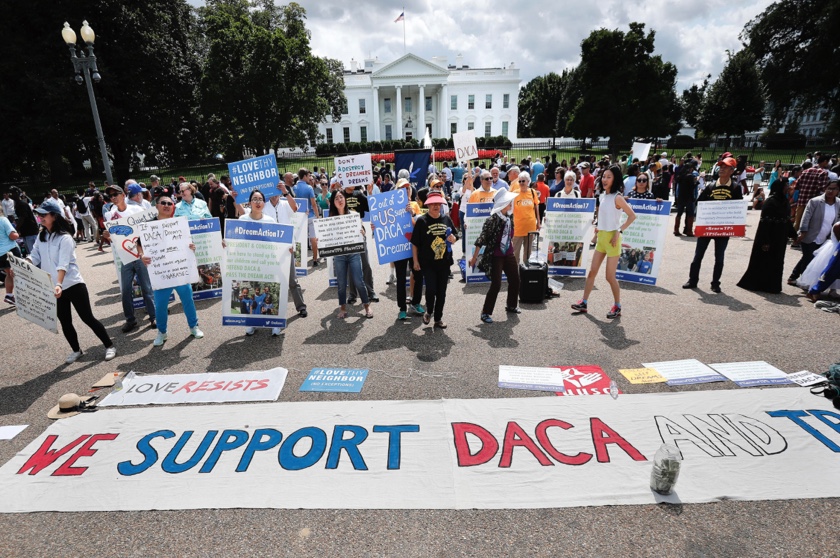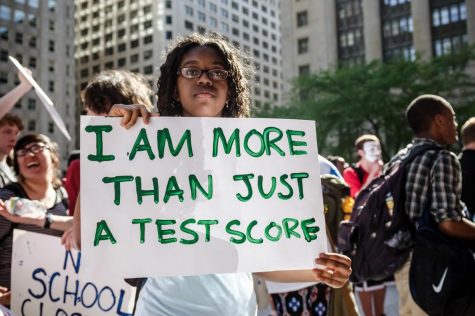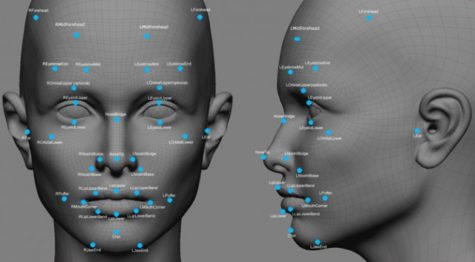DACA and Undocumented Immigrants
October 23, 2017
What does “illegal alien” or “illegal immigrant” actually mean? Today, immigration has become a difficult topic to discuss for a number of reasons. Identifying if a person is documented or undocumented has significant impacts on their rights and opportunities in the US. While Congress has strongly cautioned Americans against using “illegal” to describe people, Trump has used the term “illegal” when referring to unauthorized people. When we see an individual of enormous power, using this word as casually without caution, it creates a sense of comfort and casualty to this offensive label. There are other, more proper ways to refer to these people such as “unauthorized immigrants.”
Undocumented immigrants in this country view the description “illegal” as an offensive slur and there is a consensus in our community that the term “illegals” is an inappropriate label for undocumented citizens. Steff Kerr, a US math teacher, emphasized that, because this country is “historically not European,” giving these people this label is not “a fair description.” Gina Tangelo, an SSFS junior, highlighted that this negative connotation implies that these people are “villains when in fact they just can’t get the help that they need and deserve.” Another SSFS student, Fernanda Cordova Velasquez, had a similar argument about how the term gives a negative connotation to undocumented people and puts them in the situation where they need “to explain and receive help and support because they are seen as threatening.”
Imagine this: life has been hard and it only gets harder. You do not have a place to call home, literally. Not only do you consistently not have a roof over your head, you also are fleeing from a larger overarching conflict. You cannot live in your country due to danger and threats. You have no clue where to begin looking for aid but you do know of a land of fortune and hope. There, you will get help. Regardless of what happens there, it will be better than what is going on where you are now. What do you do to escape this horrific reality? While this is not the only story of migration from foreign countries, it is a prominent one. Immigrants, more often than not, come to the US out of a fear to see how worse life will get, a mission to stay alive, and a resolve to act on whatever deeds regardless of the risk.
The Consideration of Deferred Action for Childhood Arrivals (DACA) started by former President Barack Obama, was created in 2012 to be a “temporary relief of deportation” and give participants a working permit. During his campaign, he repeatedly emphasized his actions against sects of immigration as one of his future goals. Among other things, Trump promised an immediate halt to DACA. Just a few months into his term, Trump has already acted on this. This policy protected 690,000 undocumented youth in America and he has since stopped the acceptance of new applicants. It protected young undocumented immigrants who met the following criteria:
- Under the age of 31, as of June 15, 2012
- Came to the United States before your 16th birthday
- Lived in the U.S. since June 15th, 2007
- Were in the U.S. on June 15th, 2012
- Came to the U.S. without documents before June 15, 2012
- Is currently studying, have a high school completed education, or served the military
- Had not been convicted of a felony, or significant misdemeanor
Trump has had a different approach to dealing with undocumented people in America than previous presidents. The 2017 statistics of America show that 11.3 million people are undocumented in America, meaning that 3.4% of the 323 million people in America are undocumented. In the months falling between February and July, we saw at least 50,000 removals suggesting that Trump has been unafraid to act on his campaign trail promises. Illegal immigration has been minimized and deportation has been maximized. While Trump has stated that he wants to “work something out” for Dreamers, “[doesn’t] want to hurt those kids,” and “loves” Dreamers, his executive actions offer conflicting messages. When Trump makes these remarks on television or tweets on social media, his objective is solely to inflate his own self-image. In reality, he makes his image seem blurry, shallow and uncertain.
In a series of interviews, I asked a couple of students and adults on campus about what they thought about Trump repealing DACA. The most common response? Trump is not handling this efficiently. Cassie Parkinson, a sophomore at Amity Regional High School, a student justified in his lack of respect for Trump’s DACA repeal by saying that it is” not their fault their parents took them America.”
The media has a very strong influence on how undocumented immigrants and DACA are perceived. News headlines impact our understanding of immigrants through the terms used the use what parts of the person’s life they highlight. I googled the acronym “DACA,” and the two top stories side-by-side conflicted how they presented undocumented people. The first article was titled, “Illegal alien accused of murdering 18-year old was in DACA program” and shows an infuriated man’s mugshot. Article two was titled, “DACA changes life for student, mother” and has the image of a smiling woman. In just these two examples, undocumented immigrants were being depicted in two completely different ways.
While the first story might negatively impact the perception of undocumented people, the second article gives us a sense of tolerance for those same undocumented individuals. Do the pros outweigh the cons or vice versa? This is a conversation that could go on and on. One thing we can do is commit to cover and investigate the effects of repealing DACA. We should look into the statistics on immigration, see the effects on South American countries, learn the stories of the undocumented families, understand what America envisions for the country’s future and recognize the impacts of the repeal of former DACA participants when their permits expire and they cannot reapply.
Resources:
USCIS Staff. “Consideration of Deferred Action for Childhood Arrivals (DACA).” USCIS, www.uscis.gov/archive/consideration-deferred-action-childhood-arrivals-daca.
Meckler, Laura. “DACA Currently Enrolls About 690,000 Immigrants, Homeland Security Says.” The Wall Street Journal, Dow Jones & Company, 7 Sept. 2017, www.wsj.com/articles/daca-currentlyenrolls-about-690-000-immigrants-homeland-security-says-1504818726
Gomez, Alan. “Undocumented immigrant population in U.S. stays flat for eighth straight years.” USA Today, Gannett Satellite Information Network, 26 Apr. 2017, www.usatoday.com/story/news/world/2017/04/25/undocumented-mmigrant-population-united-states/100877164/.
Emily Shugerman New York. “Trump administration has ordered deportations of 50,000 people since he took office.” The Independent, Independent Digital News and Media, 8 Aug. 2017, www.independent.co.uk/news/world/americas/us-politics/trump-deported-500000-immigrants-department-of-justice-undocumented-immigration-a7883466.html.








Muhammed Baldeh • Nov 1, 2017 at 11:18 am
This article really helped me understand the DACA program a lot more. When I heard that Trump suspended the DACA program I just viewed as Trump doing some more outlandish things. However after reading the article, I really empathize with the people affected by our president’s decisions. True, immigration is an issue in the United States but I do believe that deporting thousands of people to lands foreign to them is not the solution.